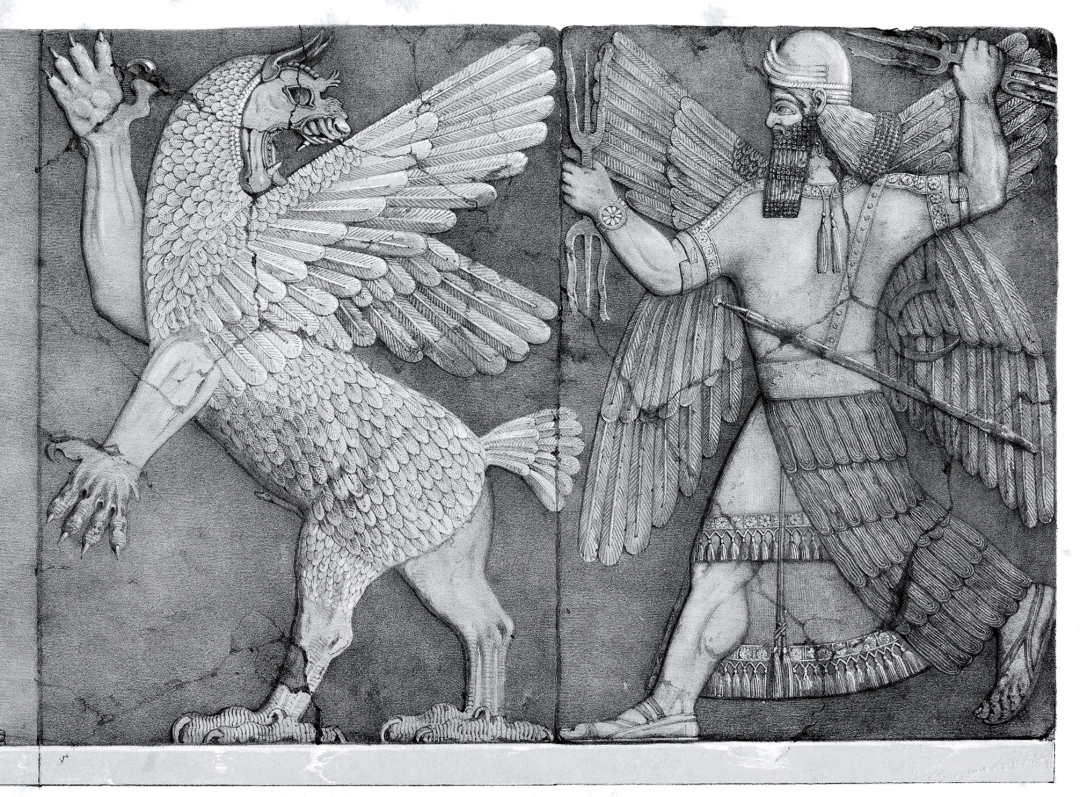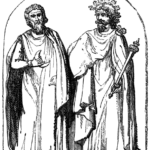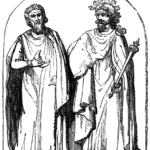With over 30 separate cultures packed within a few narrow agricultural bands, the ancient Near East of the Bronze and early Iron Age is an incredibly rich depository of culture and religion. However, it can be easy to overlook the spiritual beliefs of all the fertile trading empires that arose and fell, overshadowed as they have been by the great monotheisms to arise out of this region. Judaism and the Egyptian religions are deliberately omitted in this article: to concentrate on lesser-known ancient Middle East religions.
Two dominant themes of Near Eastern religions
Near Eastern religions were generally polytheistic within two dominant themes: the local deity who watched over the individual city-state; and the deities who watched over the cosmic cycle of life. Local deities were sometimes linked with a specific aspect of a greater deity: we see modern echoes of this pattern even in Christianity, in the patron saints of individual cities. The regional ruler would also frequently be linked with the local deity or even partake of their divinity: for example, the ruling Kidinuids of the mid-Elamite period identified themselves as servants of Kiriwashir, a deity of whom we know little except the name.
Life cycle deities reverberated the duality of male and female into sky and earth and then into the skies and the stars themselves: day and night, sun and moon. Each deity had his or her own assigned place in the heavens, borrowing the framework of the skies to assign specific spheres of influence. Even the underworld had its symbolic echo in the heavens, in that southern section of the sky below the ecliptic circle (and thus sweeping toward what a northern hemisphere culture could never see). So powerful were the links between many Near Eastern cultures that the same planet would take on the same association within several different pantheons, even where the specific name of the deity changed. Often these associations would continue even into Minoan, Greek, and Roman theology: the Hammurabic god-king Marduk bears many of the same aspects as the Roman Jupiter.
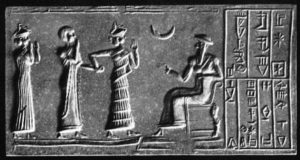 Symbolically linking the great life cycle to the stars grew into a perceived close correspondence or even causal relationship between events in the heavens and events on earth. Early religion always has qualities of attempted control over an unpredictable world through appeasement ritual and divination. In the Near East, these qualities took an astrological shape. In fact, the structure of our modern astrology can be traced directly to Babylonian and Assyrian theological divination. As it was on earth, so it could be seen in the heavens. Wise men, or “magi” (as they came to be known in Zoroastrian Persia), studied the stars and acted on what they read in them.
Symbolically linking the great life cycle to the stars grew into a perceived close correspondence or even causal relationship between events in the heavens and events on earth. Early religion always has qualities of attempted control over an unpredictable world through appeasement ritual and divination. In the Near East, these qualities took an astrological shape. In fact, the structure of our modern astrology can be traced directly to Babylonian and Assyrian theological divination. As it was on earth, so it could be seen in the heavens. Wise men, or “magi” (as they came to be known in Zoroastrian Persia), studied the stars and acted on what they read in them.
In parallel to the writing of the stars is the magic of the written word. To commit an idea into writing is to shape reality, to share in the power of creation. Thus, in common with the religions of many newly literate cultures, writing itself was commonly seen as having sacred, magical properties in ancient Near Eastern religions: and surviving written spells and amulets abound.
Perhaps because ancient Near Eastern belief is temporally closer to its appeasement/divination roots, religious morality in its familiar modern sense is curiously lacking among much of Near Eastern religion. Even Zoroastrianism, the most morally dualistic of the Near Eastern religions, only separates out a desirable state of order from chaos, a continually and actively creative principle (Ahura Mazda) from an entropic primal chaotic principle (Angra Mainyu); in a manner not dissimilar to the Christian Cathar heresy. Instead, what is generally found is a pattern of ritualistic practice and increasingly codified law that continually reinforces man’s appropriate role and duties in the world. Divine wrath is not arbitrary but is more often provoked by human failure in humility than by human failure of morality.
Nor (with the exception of Zoroastrianism) is there punishment or reward in the afterlife, except insofar as some favored mortals, almost invariably kings and rulers, might come to stand closer to the gods and sometimes even to be counted among their number. Everyone else, regardless of their acts in life, is committed to the underworld, which virtually every Near Eastern religion has defined as being an inert, arid, sunless, cavern, often surrounded by a body of water that can only be crossed in one direction: this may be symbolically evocative of man’s origin from dust or clay: being made of dust, man shall return to dust. Although Zoroastrianism does contain the moral injunction upon free-willed humanity to strive toward order and positive creation, not until the Hellenic Greeks, can there be found any suggestion that a ruler might commit acts punishable by the gods; or that such punishment might extend to the afterlife.
The oldest traceable civilization in the Near East and one of the earliest sedentary cultures of the entire world is Sumer, which has given us the Epic of Gilgamesh. Its artifacts have been dated back more than six millennia. Here the sky-earth duality becomes Anu, the sky god and ruler, and Ki, his consort. Nanna, the moon, is also considered an aspect of the Sumerian great mother goddess; while Utu, the sun, carries connotations of justice and written law. The rest of the pantheon is the Anunnaki (lit. offspring of the lord). Enlil is lord of the ghost-land underground and governs all magic and binding spells. Enki (the Babylonian Ea) is the ruler of the freshwater springs and a friend to man; his domain includes law, writings, arts, sciences, and generally all the elements of civilization. Enlil is associated with the ancient marshland village of Nippur; Enki with the cosmopolitan port of Eridu. Other major deities are Inana, the mother goddess of fertility associated with the planet Venus, who would become the Babylonian Ishtar.
The spread of cultural influence is echoed in mythology.
Even as Ur became an outgrowth of Nippur, so its moon god became a son of Enlil. Babylon, however, is the true child of Eridu: and Babylonian religion borrows heavily from its Sumerian ancestor, bearing much the same relationship to its Sumerian counterpart as the Roman pantheon does to the Greek. In time, Babylon came to be seen as the holy city by much of the Near East, where the only legitimate rulers of the Mesopotamian region would be crowned and from which they ruled; although the divine nature of those rulers was abandoned during the Kassite period. However, even where the specific ruling empire changed, the continued military and cultural dominance of Babylon frequently caused all things Babylonian to be seen as a threat and a morality tale by outlying cultures such as Judea, whose temple would be sacked by Nebuchadnezzar during one period of Babylonian expansionism.
The Minoan civilization
Outermost of the ancient Near Eastern cultures, the Minoan civilization may perhaps be among the most heavily matrilineal, goddess-oriented societies we know of, although this assessment is based heavily upon surviving art. While its origins are uncertain, strong trading links between Crete and Egypt suggest possible origins for the bird-headed deities, snake goddesses, and sun-disk representations found on seals and seal-impressions. Another strong association with Minoan religion was the bull-cult, which seems almost a cross between the worship of the Egyptian cow-goddess Hathor and the Mithraic bull-sacrifice.
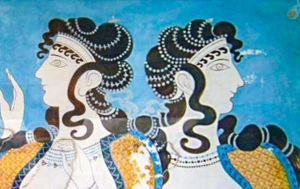 Very much unlike mainland Greece, Minoan centers of worship were generally chthonic: over 300 sacred caves have been identified. While animal and vegetative sacrifice was a common practice throughout the entire region, human sacrifice may possibly have been practiced shortly after the volcanic explosion of Santorini and Thera, which certainly severely damaged if not entirely destroyed existing agriculture and trade. Until it was superseded by the Greek Mycenaean culture shortly afterward, Crete had been one of the trading centers of the eastern Mediterranean.
Very much unlike mainland Greece, Minoan centers of worship were generally chthonic: over 300 sacred caves have been identified. While animal and vegetative sacrifice was a common practice throughout the entire region, human sacrifice may possibly have been practiced shortly after the volcanic explosion of Santorini and Thera, which certainly severely damaged if not entirely destroyed existing agriculture and trade. Until it was superseded by the Greek Mycenaean culture shortly afterward, Crete had been one of the trading centers of the eastern Mediterranean.
Zoroaster was born in Persia, and Persia continued to be the heart of Zoroastrian worship until Islam arrived there many centuries later. Quite possibly the first religion based on revealed scripture (the Avesta), Zoroastrianism dates back at least to 1200 BCE, with some indications that it might be older still. However, the first known written records that can be reliably dated are the Histories of Herodotus (~ 440 BCE). Astrology and astronomy may have reached their greatest ancient heights through Zoroastrian theology; in fact, the religion is perhaps best known today through the three Magi who followed a star. Its principles are believed to have strongly influenced the Judeo-Christian-Islam revelations; and uniquely among polytheistic religions, its worshippers are recognized by modern-day Islam as being among the People of the Book, sharing in the chain of the revelation of which Muhammad is the seal. Its primary principle is the duality of creation and destruction: thus reaching toward pseudo-monotheistic worship of the only deity worthy of worship, the creator Ahura Mazda. Part of this worship is to participate actively and positively in life. In fact, all parts of its morality can be broken down into the injunction toward good thoughts, good words, and good deeds. While hell does exist, it is a temporary condition, as in time all souls will be reunited with their fravashi, or guardian spirits. In common with all other revelatory scripture, Zoroastrianism also has a clear end of time, when an order will finally prevail over chaos.
Yet other Near Eastern powers, such as the Hittites, were heavily absorptive in their beliefs; and as a result, ended up transplanting and cross-fertilizing belief elements from a broad section of Slavic Europe and Asia. In a similar manner and a millennium later, the Romans would end up transplanting the Mithra cult from its ancient Zoroastrian roots to as far away as Celtic Britain.
Although some of the ancient Near Eastern religions have been revived in modern pagan worship, only Judaism and Zoroastrianism (Farsi) survive in the world today as living religions in an evolved version of their original form; although the number of living Zoroastrians has been estimated at fewer than 200,000, most of them in India and Iran.

